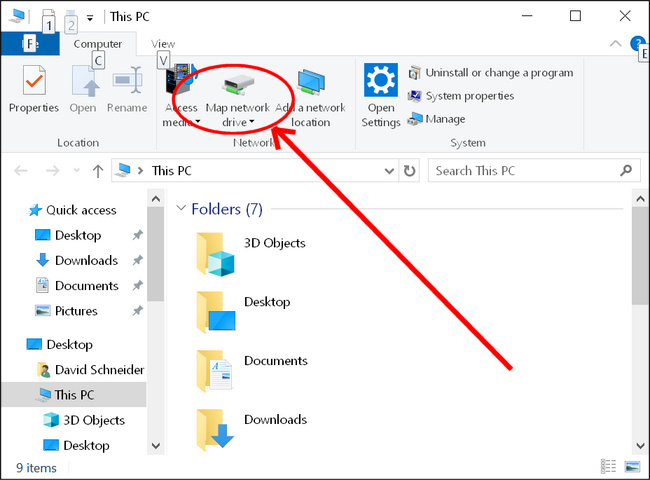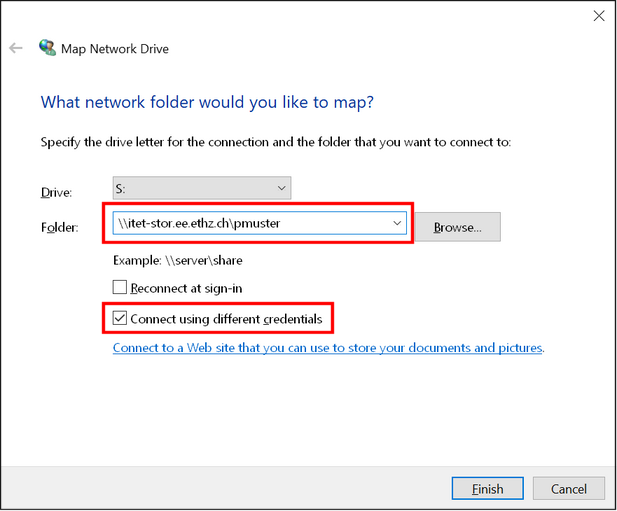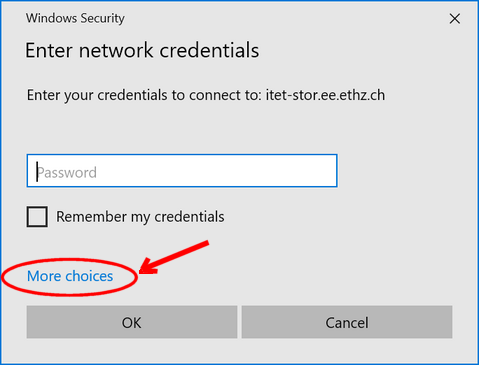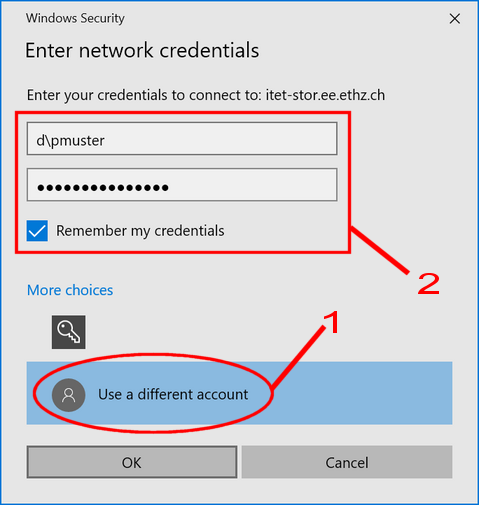|
Size: 1638
Comment:
|
← Revision 34 as of 2020-09-22 20:50:44 ⇥
Size: 1723
Comment:
|
| Deletions are marked like this. | Additions are marked like this. |
| Line 1: | Line 1: |
| #rev 2020-09-22 davidsch |
|
| Line 7: | Line 9: |
| 1. Click the computer icon ("This PC") on the Windows desktop, then click the 'Map network drive' button from the upper ribbon bar of the opened folder window: {{attachment:netdrive01.png}} | Click the computer icon ("This PC") on the Windows desktop, then click the 'Map network drive' button from the upper ribbon bar of the opened folder window: {{attachment:netdrive01.png}} |
| Line 9: | Line 12: |
| 2. In the dialog box that appears, choose the drive letter you want to use for this mapping: | In the dialog box that appears, choose the drive letter you want to use for this mapping: |
| Line 12: | Line 15: |
| The URI to your folder is `\\itet-stor.ee.ethz.ch\YOUR-USERNAME`. In this example we chose `pmuster` as the username. Replace `pmuster` with your own ETH username (login name). Activate the checkbox "Connect using different credentials" and if you desire it, set "Reconnect at sign-in" to make the network drive mapping persistent between computer reboots. Then click the "Finish" button. | The URI to your folder is `\\itet-stor.ee.ethz.ch\YOUR-USERNAME`. In this example we have chosen `pmuster` as the username. Replace `pmuster` with your own ETH username (login name). Activate the checkbox "Connect using different credentials" and, if you desire it, set "Reconnect at sign-in" to make the network drive mapping persistent between computer reboots. Then click the "Finish" button. |
| Line 14: | Line 17: |
| A new dialog box opens to enter a password: | A new dialog box opens to enter a password (do not yet enter the password there). Instead of entering a password, click "More choices": |
| Line 18: | Line 21: |
| Instead of entering a password, click "More choices", then click "Use a different account" (1). The window looks now as follows: | Then click "Use a different account" (1). The window looks now as follows: |
| Line 24: | Line 27: |
| As username, enter `d\YOUR-USERNAME`, and as password, use your ETH password. When done, click on OK. You can now access your personal `itet-stor` share in Windows Explorer under the chosen drive letter (`S:` in this example). | As username, enter `d\YOUR-USERNAME`, and as password, use your ETH password. When done, click the OK button. You can now access your personal `itet-stor` share in Windows Explorer under the previously chosen drive letter (`S:` in this example). |
Windows Network Drive
You can access your home and project directories by mounting \\itet-stor.ee.ethz.ch\username as a network drive in Windows. In this example, we will make \\itet-stor.ee.ethz.ch\pmuster available under the drive letter S.
If you do this from outside ETH, you need to establish a VPN connection first.
Click the computer icon ("This PC") on the Windows desktop, then click the 'Map network drive' button from the upper ribbon bar of the opened folder window: 
In the dialog box that appears, choose the drive letter you want to use for this mapping: 
The URI to your folder is \\itet-stor.ee.ethz.ch\YOUR-USERNAME. In this example we have chosen pmuster as the username. Replace pmuster with your own ETH username (login name). Activate the checkbox "Connect using different credentials" and, if you desire it, set "Reconnect at sign-in" to make the network drive mapping persistent between computer reboots. Then click the "Finish" button.
A new dialog box opens to enter a password (do not yet enter the password there). Instead of entering a password, click "More choices":

Then click "Use a different account" (1). The window looks now as follows:

Fill in the username and password fields (2). As username, enter d\YOUR-USERNAME, and as password, use your ETH password. When done, click the OK button. You can now access your personal itet-stor share in Windows Explorer under the previously chosen drive letter (S: in this example).